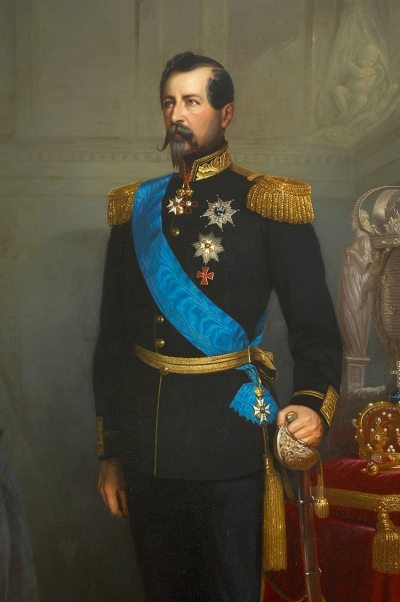Sweden and Norway or SwedenNorway (Swedish: Svensk-norska unionen; Norwegian: Den svensk-norske union(en)), officially the United Kingdoms of Sweden and Norway, and known as the United Kingdoms, was a personal union of the separate kingdoms of Sweden and Norway under a common monarch and common foreign policy that lasted from 1814 until its peaceful dissolution in 1905.The two states kept separate constitutions, laws, legislatures, administrations, state churches, armed forces, and currencies; the kings mostly resided in Stockholm, where foreign diplomatic representations were located. The Norwegian government was presided over by viceroys: Swedes until 1829, Norwegians until 1856. That office was later vacant and then abolished in 1873. Foreign policy was conducted through the Swedish foreign ministry until the dissolution of the union in 1905.
Norway had been in a closer union with Denmark, but Denmark-Norway's alliance with Napoleonic France caused the United Kingdom and Russia to consent to Sweden's annexation of the realm as compensation for the loss of Finland in 1809 and as a reward for joining the alliance against Napoleon. By the 1814 Treaty of Kiel, the King of Denmark-Norway was forced to cede Norway to the King of Sweden, but Norway refused to submit to the treaty provisions, declared independence, and convoked a constituent assembly at Eidsvoll in early 1814.
After the adoption of the new Constitution of Norway on 17 May 1814, Prince Christian Frederick was elected king. The ensuing SwedishNorwegian War (1814) and the Convention of Moss compelled Christian Frederick to abdicate after calling an extraordinary session of the Norwegian Parliament, the Storting, to revise the Constitution in order to allow for a personal union with Sweden. On 4 November the Storting elected Sweden's king, Charles XIII, as the King of Norway, thereby confirming the union. Continuing differences between the two realms led to a failed attempt to create a separate Norwegian consular service and then, on 7 June 1905, to a unilateral declaration of independence by the Storting. Sweden accepted the union's dissolution on 26 October. After a plebiscite confirming the election of Prince Carl of Denmark as the new king of Norway, he accepted the Storting's offer of the throne on 18 November and took the regnal name of Haakon VII.
Oscar I (born Joseph François Oscar Bernadotte; 4 July 1799 – 8 July 1859) was King of Sweden and Norway from 8 March 1844 until his death. He was the second monarch of the House of Bernadotte.
The only child of King Charles XIV John, Oscar inherited the thrones upon the death of his father. Throughout his reign he would pursue a liberal course in politics in contrast to Charles XIV John, instituting reforms and improving ties between Sweden and Norway. In an address to him in 1857, the Riksdag declared that he had promoted the material prosperity of the kingdom more than any of his predecessors.

1844Mar, 8
King Oscar I ascends to the thrones of Sweden and Norway.
Choose Another Date
Events on 1844
- 8Mar
Union between Sweden and Norway
King Oscar I ascends to the thrones of Sweden and Norway. - 23May
Bahá'í Faith
Declaration of the Báb the evening before the 23rd: A merchant of Shiraz announces that he is a Prophet and founds a religious movement that would later be brutally crushed by the Persian government. He is considered to be a forerunner of the Bahá'í Faith; Bahá'ís celebrate the day as a holy day. - 24May
Old Supreme Court Chamber
Samuel Morse sends the message "What hath God wrought" (a biblical quotation, Numbers 23:23) from the Old Supreme Court Chamber in the United States Capitol to his assistant, Alfred Vail, in Baltimore, Maryland, to inaugurate a commercial telegraph line between Baltimore and Washington D.C. - 27Jun
Death of Joseph Smith
Joseph Smith, founder of the Latter Day Saint movement, and his brother Hyrum Smith, are killed by a mob at the Carthage, Illinois jail. - 22Oct
Great Disappointment
The Great Anticipation: Millerites, followers of William Miller, anticipate the end of the world in conjunction with the Second Advent of Christ. The following day became known as the Great Disappointment.

 English
English  español
español  français
français  português
português  русский
русский  العربية
العربية  简体中文
简体中文 